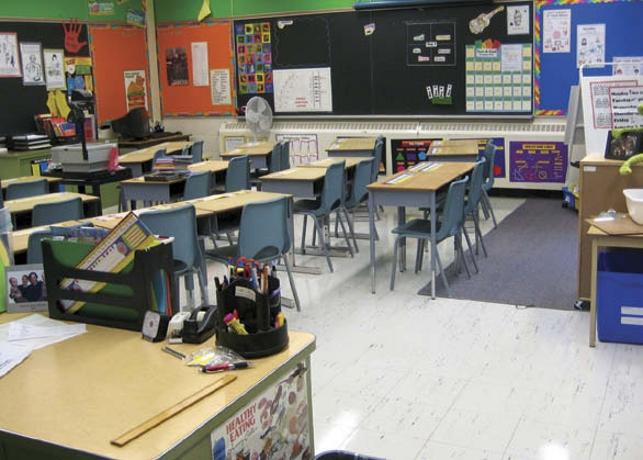
ETFO Celebrates 10 Years of Success: Ten Years and It's Back to the Classroom for this Teacher
This September, after several years as a program resource consultant and a term as an acting vice-principal, I’m returning to the classroom. By the time you read this, dear colleagues, I’ll have been teaching my 3/4 split in southwest Mississauga for nearly two months. I’ll be in the throes of report cards, mucking about with ELL stages of proficiency, mandatory Spec. Ed. comments, parent calls, pizza money, and chasing kids down to stack their chairs at the end of each day. These are all things I haven’t done for the past five years, nearly half my teaching career! And as I pack boxes in my little VP’s office, and make arrangements for a friend with a van to help me dust off and clear out the bins in my garage in August, I can’t help but reflect how things have changed over the last decade.
Apart from the fact that I now have about 37 bins of “stuff ” more than I did when I graduated from OISE 10 years ago and took the first Intermediate job I was offered at a little country school in my board’s north end, I also have more knowledge in my head and more tricks up my sleeve! My appetite for learning has not subsided over the past 10 years, and I read as many books and attend as many workshops as I did when I first became a teacher (though many of the latter I attend as a facilitator rather than as a participant). The past decade has seen me move from unconscious incompetence (as a first-year teacher, I didn’t know how muchI didn’t know!) to conscious incompetence (I soon discovered how much more there was to learn!). I’m now moving steadily further into the consciously competent phase of my career: I know I’m a good educator, but I often still have to think about the moves I make when I interact with students, colleagues, a new concept in Math, a complex instructional strategy I want to try out on my class, and so on. How I admire my senior mentors, who appear so effortless in their unconscious competence, as only time and experience can provide! Ironically, I spent part of this summer training teacher candidates as they prepare to enter the profession, so I had plenty of opportunity to become conscious about my teaching practice!
A changed job market
I remember deciding after my first few years of teaching to test the waters and see what else was out there. Teaching positions were plentiful, and for someone lucky enough to have started her career with a strong mentor administrator as I had, the job offers came fast and furious. I had my pick of schools, teaching positions, principals to work for. This time on the interview circuit, the pickings were slim, and those positions that interested me were primarily in some of the many schools in our board that had acting principals at the helm: retired folk come back to help out the board, or inexperienced people plucked from other positions to help fill the gap.
It seems the market has shifted from a large availability of teaching posts to an enormous need for school leaders. And people can smell the blood in the water. Like ravenous sharks, they take the plunge – perhaps before they are really “ready” – and swim furiously through the promotion process to vie for one of the bountiful spots in administration. Indeed, many of us now find ourselves in the interesting position of working for someone who may have only a few years of teaching experience under his or her belt, and whose knowledge of school leadership is largely theoretical rather than experience-based. How will those of us who are more seasoned veterans of the profession step up to the plate to support our many young leaders as they learn to lead our schools in an increasingly complex world?
The kids have changed too!
Instead of Yu-Gi-Oh! cards and Walkmans, now it’s Game Boys and iPods. Cheat notes during tests have been replaced in some communities with text messages being sent via cellphones. Whereas we used to call home and get some help with difficult students, now we call home to defend ourselves in front of increasingly edu-savvy families who struggle to support the work of the schools while their children spend evenings posting malicious notes to one another’s Facebook accounts. There are more autistic children in our schools, and an apparent increase in behavioural challenges as teachers strive to juggle the many ways to meet the diverse needs of their classes. Brain-based Teaching, Differentiated Instruction, Critical Literacy, and many other ideas and theories have joined the “old standards” of Multiple Intelligences and Cooperative Learning that were considered hot and new when I was starting out. And how do we know if we are meeting students’ needs?
Assessment has changed, too. In my first year of teaching, we did assessment at the end of each term in order to come up with a mark for the “new” report card. Now we use assessment to inform our instruction at the beginning of and throughout the teaching cycle. We used to sign up for one-off workshops; now we meet with colleagues to “moderate” student work several times a year. Formerly, the staffroom was abuzz with that awful thing Johnny did before recess today. Now we talk about data walls, student continuums and … that awful thing Johnny did before recess!
A new political climate
When I left teachers college a decade ago, it was with the strong memory of practice-teaching blocks spent on the picket line, as my future colleagues took job action against the hostile government of the time in order to protect the rights of our students and the future of our profession. As I entered my own first classroom, resources were scarce, and every year I spent a lot of my own money to set up my program. Curriculum documents arrived on my desk September 1 for implementation September 5, without any kind of practical support.
Today, a steady stream of new documents and resources from the ministry appears in our schools to support teachers in a variety of educational contexts. The GEIR (Guide to Effective Instruction in Reading), the GEIM (Guide to Effective Instruction in Mathematics) for each math strand at both the Junior and Primary levels, and DVDs from the Literacy and Numeracy Secretariat are just a few of the plentiful quality resources we have received lately. And when we’ve devoured those, we can head online to an e-workshop to see the theories in action and test our knowledge. We have money for math manipulatives, release time for in-school PD, and literacy resources at various divisional levels. On any given summer day, I can sign up for free, government-sponsored PD. Even the ETFO Summer Institutes have multiplied, thanks to an influx of funding from our current government.
Kids, teachers, political climate … Is it really that things have changed so much, or is it merely that I have grown more insightful and reflective with age and experience? I know at least one thing hasn’t changed, and that is my enthusiasm for the profession. Whether as a classroom teacher, a program resource consultant, or an acting vice-principal, nothing excites me more than a strong lesson plan carried out with appropriate flexibility to meet the needs of a group of diverse students working together on this thing called “learning.” But before I launch into that realm at the classroom level once again, I need to find a Canada border for my bulletin board and get some pillows for my reading corner!

